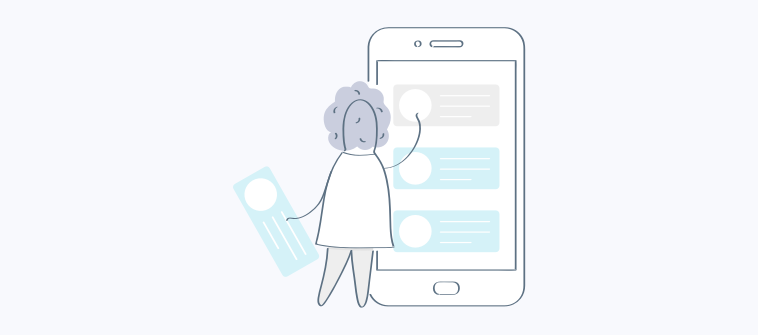
When you start a small business, you begin with a blank slate. Every decision you make builds the foundation for your enterprise’s future. If you want to build a solid foundation, create a compelling brand that resonates with your target audience. For this, providing excellent experiences to your customers is a prerequisite. Don’t forget that 63% of consumers expect a personalized experience from a business, which further reinforces the paramount importance of crafting unique and personalized experiences.
How to Personalize the Customer Experience
Your brand is everything consumers associate with, including your company name, logo, color scheme, products or services, storefront, and—of course—how you treat your customers.
To build a brand that packs a punch, treat your customers as the individuals they are – personalize, personalize, personalize. Besides personalization, give them your time, empathy, and commitment at every point.
Of course, for the best outcomes from building a positive brand, every business needs to have a unique logo. You can see great brand identities created by some top logo design agencies that are popular in today’s market.
Take a look at some of these tips to get you on the right track to personalizing customer experiences:
1. Make Yourself Available When Customers Are Shopping
The point of sale is a huge opportunity to wrap up a customer’s shopping experience. A simple question, “Did you find everything you were looking for?” has the potential to turn into a conversation and lasting business relationship.
But before you get to the point of sale, you should also make yourself available. If you have a physical storefront, offer customers your help. Give suggestions and directions as needed, and go above and beyond to lend a helping hand.
If you have an online store, the best way to assist visitors is by creating an online FAQ section. It will give them all the details they need regarding your products and services. The fact that FAQs can be accessed easily on mobile phones makes it even easier for customers to self-serve. It enables them to find answers to their questions and take the final call of whether to go for the purchase or not.
2. Create Personalized Marketing Materials
When you market to customers, what’s your strategy? Do you send mass emails that use the same template for every customer? Do you move customers through the same funnel even if they’ve already seen a message before?
Or do you take the time to personalize emails and other marketing materials? No, personalizing emails doesn’t keep you from automating your work. It does, however, contribute to positive brand-building.
According to a survey, consumers find it “very frustrating” when they:
- Receive an offer for something they have already purchased (34%)
- Receive offers that aren’t relevant (33%)
- Aren’t recognized as existing customers by the company (31%)
The statistics above make it very clear that customers want to receive personalized emails. But for personalizing your marketing materials, you need to do a little homework.
You can use customer relationship management or marketing automation tools to track critical customer data. Make sure your marketing materials reflect information about your consumers, such as-
- Names
- Purchase history
- Interests
- Whether they fall under new or existing customer category
Adding a little personalization to your marketing materials can work wonders. It helps you build a customer-focused brand. On the other hand, if you don’t tailor your marketing collaterals as per your target audience and customers, chances of your brand being perceived as spammy and annoying are quite high.
3. Promote Your Relatable Startup Story
Who doesn’t connect to someone with a relatable story? People like stories that can immerse and connect them to others. The same goes for your business. When you share your startup story with customers, be honest and relatable.
Your story should capture what you went through to morph your business idea into reality. Let’s use Patriot Software’s startup story as an example. The company started in the basement of a factory with no air conditioning or heat; flooded floors; and rats, birds, flies, and snakes. Instead of walls, there were blankets. Instead of positive cash flow, there were maxed out credit cards and family loans.
Not only is this story real, but it’s also relatable. Others who have been through similar situations (e.g., debt and loans) know the feeling. And, that real and relatable startup story is embedded in the company’s brand. That story translates to customer success because it shows customers what it means to fall and then rise, struggle and succeed. It shows them that the company cares for its customers, more than anything else and has now become a big name in the market.
Before sharing your business’ startup story, jot it down. Think of all the things you went through to get where you are today in the industry and then include the same in your marketing materials. It will not only humanize your brand but will also help customers connect better with you.
4. Don’t Give Generic Responses to Customers
Your customers are going to reach out to you. Probably a lot. They’ll reach out directly on the phone or via email. They’ll reach out indirectly on social media, online review sites, and other forums. They might reach out because they’re elated, confused, frustrated, or outright livid.
Don’t think of this as a negative sign or as an added burden on your support team. Instead, treat it as an opportunity in disguise, to build your brand. If you want to turn these conversations into a brand-building opportunity, there’s one rule you need to follow (hint, it’s the title of this section):
Don’t give generic responses!
Whether you’re talking to your customers in public (e.g., on an online review site) or private (e.g., via email), be personal.
Use their names, learn more about them, find out as much information as you can about their inquiry, and respond to that inquiry. The more you can learn about customers and their needs, the better you can tailor your responses.
Personalizing your responses according to customer requirements reminds them that you’re not just a business that finds profit in everything. Instead, you are a customer-centric brand that cares about clients.
Wrapping Up
To keep your customers happy and to get your point across, the trick is to find a balance between providing personalized customer experience and being overbearing. Your focus should be on establishing a connection with your prospects or customers and creating customized experiences for them.
FREE. All Features. FOREVER!
Try our Forever FREE account with all premium features!







